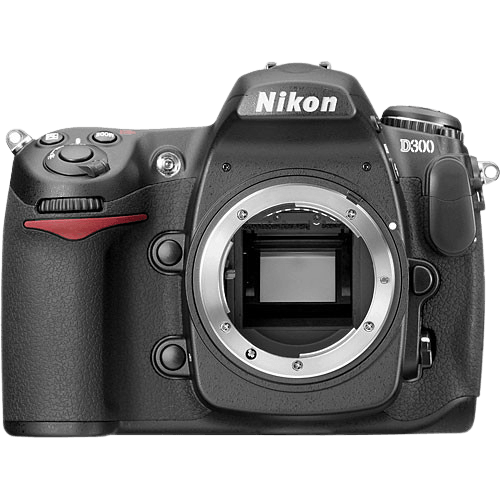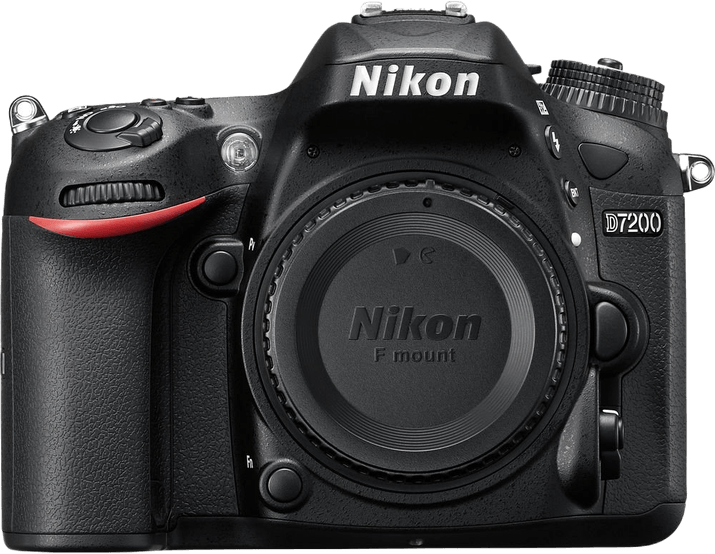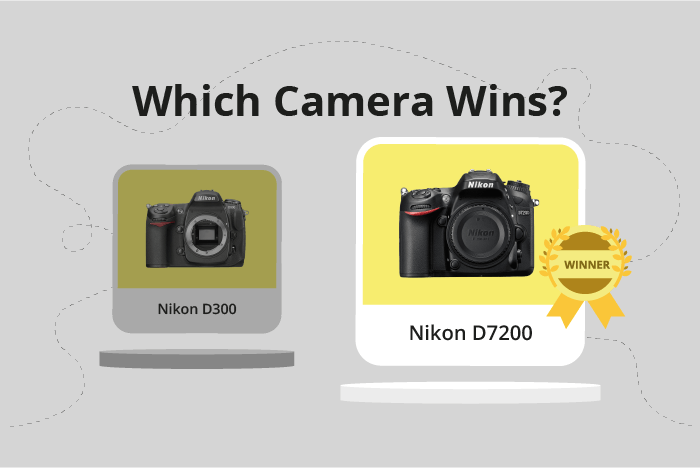Nikon D300 vs D7200 Comparison
Nikon D300

Nikon D7200

The Nikon D7200 emerges as the winner with a score of 68/100, outperforming the Nikon D300, which scored 49/100. Both cameras are DSLR models, with the D300 announced in 2007 and the D7200 in 2015. They share similarities in launch price, with the D300 at $1540 and the D7200 at $1200.
The D7200 excels in its smaller size, measuring 136 x 107 x 76mm, and lighter weight, at 765g, compared to the D300’s 147 x 114 x 74mm dimensions and 925g weight. However, the D300 has a slightly slimmer depth.
Despite the D7200’s advantages, the D300 may still appeal to those who prefer a heftier camera. Ultimately, the D7200’s higher score and improved features make it a more attractive option for most photographers.
Nikon D300 vs D7200 Overview and Optics
The Nikon D7200 outperforms the Nikon D300 in optics with a 24-point lead, scoring 71/100 compared to the D300’s 47/100. Both cameras share several specifications, such as a 6fps shooting speed, CMOS sensor type, APS-C sensor size, Nikon F DX lens mount, and the absence of image stabilization.
The D7200’s superior optics can be attributed to its higher megapixel count and more advanced processor. With 24.2 megapixels, the D7200 captures more detail and produces higher resolution images than the D300, which has 12.3 megapixels. Additionally, the D7200’s Expeed 4 processor provides better image quality and faster processing than the D300’s Expeed processor. Furthermore, the D7200’s sensor performance is superior, as evidenced by its DXOMARK score of 87, compared to the D300’s score of 67.
On the other hand, the D300 does not surpass the D7200 in any particular aspect of optics. Both cameras have the same shooting speed, sensor type, sensor size, lens mount, and lack of image stabilization. The D300’s lower score signifies its inferior performance in terms of optics.
Taking these factors into account, it is clear that the Nikon D7200 is the better choice for photographers who prioritize optics. Its higher megapixel count, more advanced processor, and superior sensor performance ensure better image quality and detail capture. The Nikon D300, while sharing some common specifications with the D7200, does not offer any advantages in the optics department.
Nikon D300 vs D7200 Video Performance
When examining the video capabilities of the Nikon D300 and Nikon D7200, it becomes apparent that the Nikon D300 does not offer any video functionality. This is an important distinction to consider for those who require video recording options in their camera.
On the other hand, the Nikon D7200 has a video score of 70 out of 100. This camera provides Full HD video recording with a maximum resolution of 1920 x 1080 pixels. Additionally, the D7200 can record video at a maximum frame rate of 60 frames per second. This camera also includes a built-in time-lapse functionality, which is a desirable feature for many photographers and videographers.
Taking these factors into account, it is clear that the Nikon D7200 offers superior video capabilities compared to the Nikon D300. For individuals who prioritize video recording in their photography needs, the Nikon D7200 is the better choice between these two cameras.
Nikon D300 vs D7200 Features and Benefits
The Nikon D7200 outperforms the Nikon D300 in features with a score of 59/100 compared to the D300’s 54/100. Both cameras share some common specifications, such as a 3-inch screen size, no touchscreen, no flip screen, no GPS, and no Bluetooth. However, there are specific aspects where one camera excels over the other.
The D7200 is superior in terms of screen resolution, boasting 1,228,800 dots compared to the D300’s 922,000 dots. This higher resolution allows for a clearer and more detailed image preview. Additionally, the D7200 includes Wi-Fi connectivity, enabling users to share images and control the camera remotely, a feature not present in the D300.
On the other hand, the D300 does not have any distinct advantages over the D7200 in the features department. It shares the same screen size and lacks additional connectivity options such as Bluetooth and GPS. In this comparison, the D300 does not outshine the D7200.
Taking into account the feature scores and specifications, the Nikon D7200 is the better choice for photographers seeking enhanced screen resolution and Wi-Fi connectivity. The D300, while still a capable camera, falls short in providing these additional features that could enhance the user experience. The difference in feature scores and the presence of Wi-Fi in the D7200 solidify its standing as the superior option between the two cameras.
Nikon D300 vs D7200 Storage and Battery
The Nikon D7200 outperforms the Nikon D300 in storage and battery, scoring 79 points compared to the D300’s 43 points. Both cameras lack USB charging, but they differ in memory card compatibility and battery life.
The D7200 has two memory card slots, accepting SD, SDHC, and SDXC cards. In contrast, the D300 only has one memory card slot and is limited to Compact Flash (Type I or II) cards. This gives the D7200 an advantage in storage capacity and flexibility. Additionally, the D7200’s battery life lasts for 1110 shots, while the D300’s battery life is slightly shorter at 1000 shots. The D7200 uses an EN-EL15 battery, while the D300 uses an EN-EL3e battery.
Although the D300 has a lower score in this category, it still provides a decent battery life and storage options for photographers. However, the D7200’s superior storage capacity, memory card flexibility, and longer battery life make it the better choice in terms of storage and battery performance.
Nikon D300 vs D7200 – Our Verdict
Are you still undecided about which camera is right for you? Have a look at these popular comparisons that feature the Nikon D300 or the Nikon D7200:

